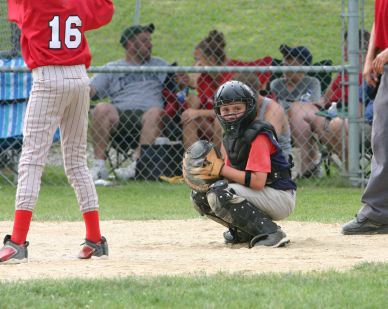In early June 2010 tragedy struck a baseball field in Arizona when a 13-year-old Little Leaguer trying to bunt was struck in the chest. He took a few steps towards first base, and then collapsed, and died the next morning. 
Getting hit by a pitch is to be expected when playing baseball. Dying is not. The Arizona boy died from a condition called commotio cordis, which is Latin for "agitation of the heart." Commotio cordis is a disruption of heart rhythm that occurs as a result of a blow to the area directly over the heart. From 1996 to 2008, the USA National Commotio Cordis Registry recorded 250 cases. Fewer than 20 percent survived.
"It is a scary thing," said Dr. Bruce Thomas, a primary care sports medicine physician in Florida and MomsTeam expert, Senior Consultant and former Head Team Physician for the Washington Nationals, and team Physician for the Brevard County Manatees, the Class A Affiliate for the Milwaukee Brewers.
Thomas said commotion cordis is believed to be an electrical event which occurs when the ball hits the right place during the right moment of the cardiac electrical cycle causing a sudden change in heart rhythm (arrhythmia).
"Blood flow essentially stops. When it stops to the brain, in seconds, the patient becomes unconscious. When it stops elsewhere it results in rapid death," he said.
Commotio cordis FAQs
Q: Why does the heart respond that way?
A: Although the exact mechanism of what occurs is unknown, it is believed that sudden death is due to an electrical event, most likely ventricular fibrillation (VF) occurring immediately upon chest wall impact. Ventricular fibrillation is like a bowl full of worms wriggling, not a coordinated, synchronized beat like the normal heartbeat.
Q: Would it have mattered a split second or two later?
A: That's a very good question and the answer is unknown. It is, however, felt that the timing of impact of the blunt chest trauma is important in the mechanism of commotio cordis. There is only a 20 to 40 millisecond window on the up slope of what doctors call the T wave (early repolarization of the ventricles-lower chambers). This has been worked out through experimental models. Interestingly, the velocity also seems to be important. A velocity of 40 mph appears to be necessary to cause the event.
Q: Is the heart actually damaged or has it just stopped?
A: For the most part, autopsy studies of these cases have shown a normal heart.
Q: Is a ball hitting someone's chest similar to doing CPR (chest compressions) on someone with a beating heart?
A: The velocity that's required to cause commotio cordis is a minimum of 40 miles an hour. This is significantly higher impact then doing chest compressions during CPR.
Q: Realistically, how hard does a ball have to hit someone to stop the heart?
A: Although the answer to this question is not definitively known it appears that the ideal velocity to cause commotio cordis is 40 miles per hour. This explains why the vast majority of these cases occur in young persons (the mean age is 15 years old), and why 75 percent of cases have occurred during athletics involving blunt projectile such as a baseball, lacrosse ball, or hockey puck.
Q: What's the danger radius around the heart?
A: Only impact occurring directly over the cardiac silhouette results in ventricular fibrillation, so it appears that the impact must occur directly over the heart.
Q: Why was this boy's heart not able to be restarted as fast as it was stopped?
A: If indeed this is caused by ventricular fibrillation, that rhythm usually requires intervention to revert back to a normal rhythm, and does not do so spontaneously. Because a heart in ventricular fibrillation does not pump blood normally, if at all, the person dies very rapidly without intervention, such as a shock delivered by an Automated External Defibrillator (AED).
Q: Clearly, seconds count, so the next time this happens can a player be resuscitated?
A: AEDs are more and more frequently seen at sporting events, and are required at most professional ball games. This may indeed allow us to resuscitate an athlete with commotio cordis, but the intervention would have to be done extremely promptly, and the rescue personnel would have to be fully trained in advance on the use of the device. That day may come.
Q: This type of tragedy seems to happen only in young players, are MLB players at risk?
A: MLB players generally fall above the age range of most commotio cordis cases. We do know that younger patients are in the risk "target zone" and not older athletes. There has not been an instance of commotion cordis in Major League Baseball.
Q: With your experience in the Major Leagues, do you know if protocols are in place if this were to happen? If so, what are they?
A: All MLB trainers, positions, and some coaches are trained in CPR and AED use. We have protocols to ensure that the AEDs are working properly and we also have AED practice sessions and CPR review sections usually during spring training. If this were to occur during a Major League game, it would be handled the same as any other sudden loss of consciousness. With trained personnel and proper equipment very close at hand the likelihood of survival would be high.
Q: In your opinion what are the keys to preventing this kind of tragedy from happening again?
A: Unfortunately, and surprisingly, commercially available chest protectors have not been shown to effectively prevent commotio cordis. Many of the commotio cordis victims reported to the national commotio cordis registry were indeed wearing protective equipment at the time of their event. In the absence of effective safety equipment, coaches should encourage players in the affected sports (baseball, lacrosse, and hockey) to turn away from oncoming projectiles whenever possible to avoid contact directly over the heart. Softer and less dense balls should be used whenever possible without changing the nature of the game. Age-appropriate safety baseballs (reduction-in-force or RIF baseballs) have indeed been shown to decrease the risk of commotio cordis.*
For more on cardiac safety in youth sports, click here.
Posted June 22, 2011; revised February 27, 2012
* Important update: In its revised Baseball and Softball Policy Statement, the American Academy of Pediatrics recommends that "children with the lowest skill level (in general, those younger than 10 years) should use the lowest-impact NOCSAE-approved [RIF] balls (level 1). Level 2 low-impact balls are designed for children 10 to 12 years of age with moderate skill levels. Children younger than 10 years of age with moderate skill levels may use either level 1 or level 2 balls. Level 3 balls are designated for youths older than 12 years and those 10 to 12 years of age withi advanced skills." American Academy of Pediatrics, Council on Sports Medicine and Fitness, Policy Statement: Baseball and Softball. Pediatrics 2012;129(3):842-856. (doi: 10.1542/peds.2011-3593)(accessed February 26, 2012)









